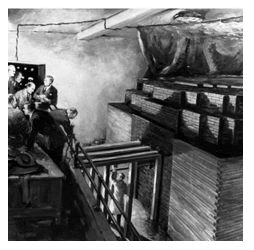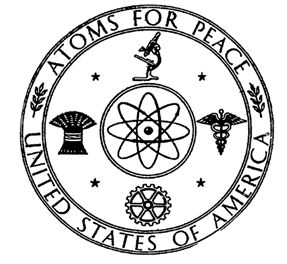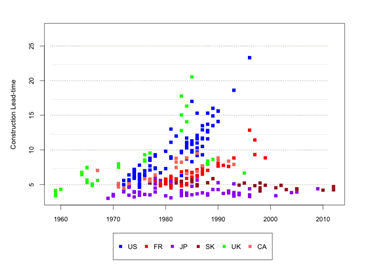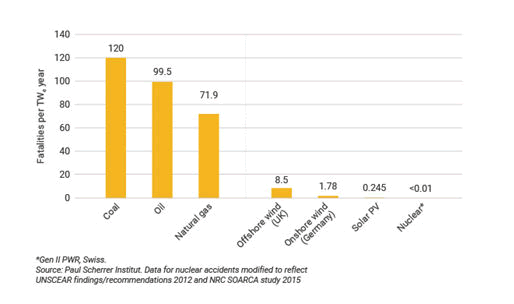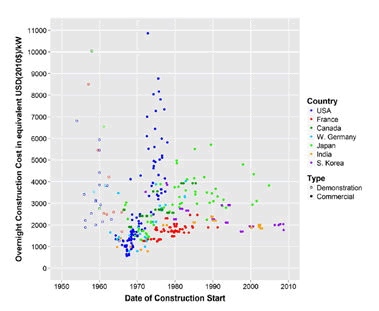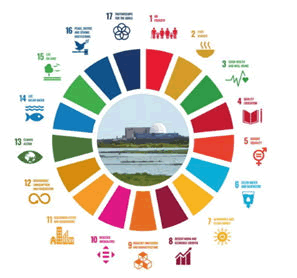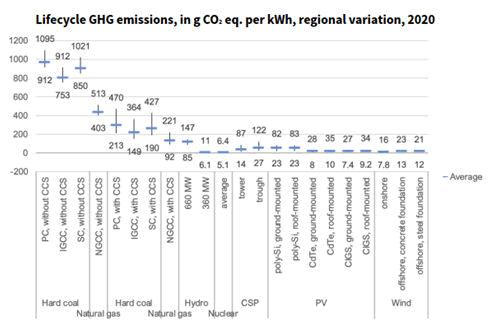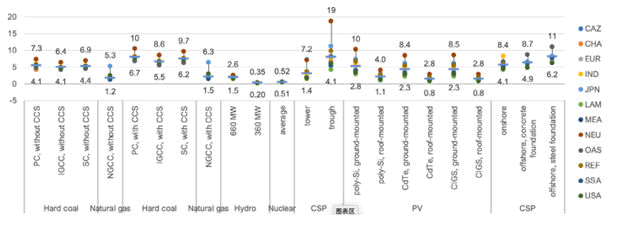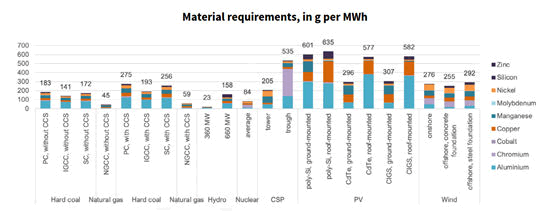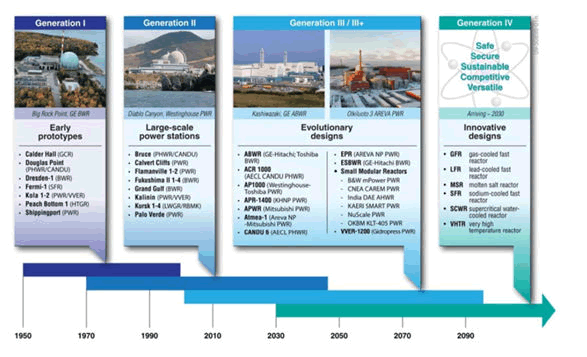Research Article, J Nucl Ene Sci Power Generat Technol Vol: 11 Issue: 6
Are we witnessing a New Nuclear Renaissance?
Lorenzo Santini*
Department of Nuclear Business Development, University of Bologna, Worley, Italy
*Correspondence to: Lorenzo Santini, Department of Nuclear Business Development, University of Bologna, Worley, Italy, Tel: 359885565359; E-mail: zannino.solerti@gmail.com
Received date: 01 March, 2022, Manuscript No. JNPGT-22-51906;
Editor assigned date: 03 March, 2022, PreQC No. JNPGT-22-51906 (PQ);
Reviewed date: 17 March, 2022, QC No. JNPGT-22-51906;
Revised date: 29 April, 2022, Manuscript No. JNPGT-22-51906 (R);
Published date: 09 May, 2022, DOI: 10.4172/2325-9809.1000282.
Citation: Santini L (2022) Are we witnessing a New Nuclear Renaissance?. J Nucl Ene Sci Power Generat Technol 11:6.
Abstract
The general consensus on the need to decarbonize the ways currently employed for producing energy is inevitably reigniting in many countries the discussion about nuclear power. The debate is still rich of opinions against this technology on the base of its alleged risks, costs and controversial origins. In the present paper, after a short overview of the origins of nuclear technology, we attempt to review such claims showing that majority of them are just baseless and anchored to unjustified assumptions.
Keywords: Unjustified assumptions; Nuclear technology; Controversial origins
Abbreviations: CSP: Concentrated Solar Power; GHC: Green House Gases; IAEA: International Atomic Energy Agency; LCOE: Leveled Cost of Electricity; NGCC: Natural Gas Combined Cycle; NPP: Nuclear Power Plant; PC: Pulverized Coal plant; PV: Photo Voltaic; PWR: Pressurized Water Reactor; SDG: Sustainable Development Goals; SMR: Small Modular Reactor; TMI: Three Mile Island; UN: United Nations
Introduction
Nuclear Power understanding and control is one of the pinnacle achievements of the 20th century, comparable only with few other discoveries/inventions brought to light by mankind such as fire, the wheel, the printing press, the invention of the steam engine, penicillin and the Rosetta stone.
Through the controlled harnessing of energy contained in the nucleus of the atom, mankind for the first time was able to obtain a power source virtually infinite, democratically spread everywhere on earth and not bound to the activity of the sun. Most, if not all diffused existing power sources before the advent of nuclear power, i.e. fossil fuels, wind, hydro, are a product of the sun’s radiation interaction with our planet. On the contrary the energy contained in an atom’s nuclei is stored since their creation that in the case of Uranium distributed on Earth is typically dated billions of years ago when a Supernova exploded in our galaxy.
On the 2nd of December 1942 Enrico Fermi and his team in the Metallurgical Laboratory of the University of Chicago brought to criticality the first human-made self-sustaining chain reaction in the so called Chicago Pile-1. The device, part of the Manhattan Project, was the final outcome of years of studies carried out by the most brilliant mind of that time and with the main purpose to produce the Plutonium needed for the first atomic bomb. In Fermi’s first reactor, natural uranium oxide was used as fuel and large blocks of graphite had the role of neutron moderator, i.e. that material needed to slow down (moderate) the speed of neutrons, thus allowing them to be more efficient in the process of atom-splitting (Figure 1).
In the same years Fermi was invited by the Navy and made several presentations on prospects for nuclear propulsion. The main advantages of such sourced energy for submarine propulsion was related to its independency from air and the incredibly high energy density of the uranium that stores in its core all the fuel needed for years of operation and hundreds of thousands of miles of propulsion. In fact 5 grams of uranium (i.e. the size of a 1cm pellet), has the same energetic content of 400 kg of coal or 350 kg of crude oil. A single coke-can of uranium can provide enough energy for an entire high-energy life.
Under the guidance of Admiral Rickover, enormous resources were poured into the naval reactor program and the final outcome was the so called Pressurized Water Reactor (PWR), the most diffused typology of reactors today equipping around 70% of the existing nuclear plants on earth. In the PWR the fuel is slightly enriched uranium oxide (rarely exceeding 5% of enrichment) and the moderator is the same water used to extract the thermal power from the core. The hot water emerging from the core is then used to boil lower pressure water belonging to another circuit, thus creating the steam that will drive the power turbines.
So from the 50s of the last century, numerous initiatives mainly carried out by the USA government started to drive the need to deploy on a grand scale nuclear power around the world. In 1953 president Eisenhower gave a speech to the UN General Assembly for supplying equipment and information to schools, hospitals, and research institutions within the U.S. and throughout the world (Figure 2).
The speech was a tipping point for international focus on peaceful uses of atomic energy. Prior to Eisenhower's speech, the state of atomic development in the world was under strict secrecy.
Around the same time of Eisenhower’s speech, even Walt Disney in the 50s put together an educational movie and accompanying book, both called ‘Our Friend the Atom’. It explained in simpler language how nuclear technology would help humankind.
The "Atoms for Peace" program opened up nuclear research to civilians and countries that had not previously possessed nuclear technology. Eisenhower argued for a nonproliferation agreement throughout the world and argued for a stop of the spread of military use of nuclear energy. The "Atoms for Peace" program also created regulations for the use of nuclear power and through these regulations stopped other countries from developing weapons while allowing the technology to be used for positive means. It created the ideological background for the creation of the International Atomic Energy Agency (IAEA) and the Treaty on the Non-Proliferation of Nuclear Weapons.
Following the momentum provided by this initiative, several countries of the World, especially in Europe, started their programs of development and installation of nuclear power stations. UK, Italy and France in particular were at the forefront of the European nuclear industry. During the 60s and 70s, generation I and II nuclear power plants were built in ~20 countries in sizes ranging between 100 and 600 MW, with construction periods between 4 and 6 years and with LCOE (Leveled Cost of Electricity) competitive with the cheapest existing energy sources.
Is nuclear technology safe?
Nuclear power growth continued at a prolific pace tilt the end of the 70s when in 1979 an accident occurred at the Three Mile Island (TMI) power station in Pennsylvania (Figure 3).
Starting from that moment lots of existing NPP orders in USA were cancelled and other in construction suffered significant cost overruns and delays due to the emotive perception about the safety of this technology. Something similar happened in Europe a decade later as a consequence of the Chernobyl accident occurred in Ukraine on the 26th of April 1986.
A third worldwide stop to the nuclear industry arrived after the Fukushima accident in Japan triggered by the Great East Japan earthquake occurred on 11th of March 2011.
It is not the purpose of the present paper to analyze those events, but there are multiple solid scientific facts showing that the decision makers significantly overreacted after these 3 accidents, in deference to human kind’s misunderstanding and fear instead of following the facts and science.
It is important to underline that, despite the propaganda brought by the media around the world, not a single person died due to radiation in the accidents of TMI and Fukushima, while Chernobyl, despite some early alarmist and perhaps political communications, caused a number of fatalities that, according to the best available science, ranges between 65 and 200. Different catastrophic conclusions trumpeted by the media in the last decades have been demonstrated to be the result of too conservative, if not antiscientific, approaches to the biological effects of radiations [1-6].
The conclusions from the United Nations Scientific Committee on the Effects of Atomic Radiation report are clear on this regard (UNSCEAR 2008): “The vast majority of the population were exposed to low level of radiation comparable, at most, to or a few times the annual natural background radiation level and need not live in fear of serious health consequences. This is true for the population of the three countries most affected by the Chernobyl accident, Belarus, The Russian federation and Ukraine, and even more so for the populations of other European Countries. Lives have been disrupted by the Chernobyl accident, but from the radiological point of view, generally positive prospects for the health of most individuals should prevail”.
Such numbers and conclusions must be put in perspective comparing them with other human related activities. Limiting the discussion to the energy field it is easy to demonstrate that nuclear power is conclusively proven to be the safest way of producing electricity with the lowest number of fatalities per TWh produced (Figure 4).
Every year hundreds of thousands of people die around the world from diseases related to pollution caused by the fossil fuels, and thousands have died in the past decades due to severe failure of large dams. In 1963 the Vajont dam in Italy overflowed due to a landslide killing 2000 people in few seconds. In 1975 Banqiao dam failure in China destroyed 5 million homes killing between 100 and 240 thousands inhabitants depending on the source. Of course hydropower was never banned by any country due to those events. Even our current ‘new energy’ optimism and love affairs with Hydrogen and Carbon Dioxide have claimed lives (Hindenburg in 1937 and Lake Nyos in 1986 respectively). Despite such evidences of the intrinsic risk of every power source, the only one that has been socially ostracized due to its alleged danger is nuclear power. The irony, as just said, is that the same power source is the safest on earth.
Only in Germany it is estimated that there’s a 1,100 excess deaths per year resulting from the local air pollution emitted by the coal-fired power plants operating in place of the shutdown nuclear plants [7]. And we’re continuously told that German nuclear phase out was driven by the aftermath of Fukushima and the intrinsic risks related to the nuclear industry.
And of course our relationship with the motorcar, arguably the biggest manmade killer on the planet aside from weapons still gives our flawed and biased human senses a feeling of “safety” as we get behind the wheel together with our children.
When in 1984 in Bhopal the Union Carbide factory producing MIC exploded killing some 3000 inhabitants, there are no evidences of any attempt from the world governments to ban or limit chemical industries operation. So why such a mediate harassment specifically targeting nuclear power?
There are multiple conjectures for this great historical anomaly and misperception relating to our education, emotion, fear, and politics and of course money. Consider these ‘business’ drivers for example:-nuclear technology employs a fuel, uranium, that is present nearly everywhere on earth and its market is by far less subject to monopolies than fossil fuels-due to the fact that nuclear is a very capital intensive investment, the impact of uranium cost on KWh cost is a small percentage of the total cost of production. For such reason the KWh produced by a nuclear power plant is not prone to fluctuations, neither exploitations driven by the fuel price variations using the most advanced nuclear technologies based on breeder reactors and closing the fuel cycle, there would be enough fuel at least for the next 6000 years, thus solving a scarcity problem that lots of powers have no interest at all in solving. Furthermore if we’ll start exploiting industrially the uranium dissolved into the seas [8], such horizon would be significantly enlarged by orders of magnitude.
Is nuclear technology expensive?
It is often stated that another reason why nuclear technology is not appetible today is due to its high costs, someone says incomparably higher than renewable energies. While such statements seem hardly deniable for the nuclear new build projects started in Europe and USA during the last decades, there are multiple evidences that a completely different picture results if all costs (including system costs) are taken into account in evaluating the LCOE of renewable energies [9].
For the USA market (but generically applicable also to Europe) Koomey and Hultman from Stanford Univ and Lawrence Berkeley Nat. Labs [10] showed in an interesting work that NPP costs and construction duration are mainly affected by the following factors:
- Rapid Regulatory Changes (both before and after TMI): such changes are often the result of “reactions” to external events polarizing the public opinion, e.g a nuclear accident
- Quality Control Problems during Construction: such problems are often the result of technical difficulties arising from the long stagnation in the nuclear industry and loss of qualified personnel for the construction
- Increase Reactor Size: the “race” to gigantism of the ’80 and ’90 of the last century (with single units reaching 1.65 GW of power) brought mainly complications in the design/construction process.
- Reduced Electricity Demand Growth (e.g. Olkiluoto, Flamanville, Mochovce NPPs)
- Utility Financial Constraints
The authors concluded that “While reactor designs have been standardized, licensing procedures have been streamlined, and construction management techniques are much more sophisticated than before, some old problems remain, and new ones may emerge”.
Methodology
A recent study appeared on Energy Policies extended the nuclear reactors costs analysis to 7 countries in total and 349 reactors around the world, i.e. 58% of the total. The countries involved in the study were USA, France, South Korea, India, Japan, Germany and Canada. The authors considered the overnight construction costs portion only.
Levering and colleagues found that trends in costs have varied significantly in magnitude and in structure by era, country, and experience. In contrast to the rapid cost escalation that characterized nuclear construction in the United States, Authors found evidence of much milder cost escalation in many countries, including absolute cost declines in some countries and specific eras.
Authors concluded that, contrary to the common “wisdom” there is no inherent cost escalation trend associated with nuclear technology (Figure 5).
- The costs of Japanese reactors beginning construction in the 1980s rise above those in the 1970s, and become less consistent between reactors, but do not appear to follow an escalation trend.
- Finally, in Korea, where nuclear power was adopted much later than all six other countries, construction costs follow a steady decline (for domestic designed reactors).
- Countries that emphasized design standardization, such as in France and Korea, see more stable costs.
- Countries that consistently built reactors in pairs, or larger sets at the same site, such as France, Canada, and Korea, see lower costs than in the USA, Japan, and Germany (with single unit NNPs)
Today the debate about nuclear reactors costs is still very active and is rich of contrasting opinions. In an era where electricity prices can easily spike to more than 20 times the normal values (cfr. European market in the last months), it becomes more and more clear that other criteria should drive the choice of an energy source, i.e. primarily the energy security and independency of a country. Such strategic security and independency can be granted by nuclear power, considering 2 of its unique aspects:
- Uranium is nearly ubiquitous on the earth crust,
- The fuel loaded in a reactor core stays there for 3/4 years before its removal and fresh fuel elements for the whole lifetime of a plant can be stored in a very small deposit adjacent to the installation.
Wouldn’t these 2 characteristic be particularly appealing for Europe in these unique times?
The need for nuclear power and its impact on the environment
Policy makers are today aligned on the need to achieve the goal of “carbon neutrality” within 2050. It is hard to estimate if such target is achievable; the challenge is for sure an incredible one. To have an idea why it is so, it’s enough to consider that the world has a yearly energy consumption of around 12 GTe/y, i.e. 12 billion of equivalent tons of oil per year. More than 80% of such demand comes from fossil fuels. If we want to replace all carbon based sources of energy within 2050 it means that during the next ~11000 remaining days we should connect to the grid ≥ 1 GW class nuclear reactor every single day, or alternatively, 5000 typical wind generators (assuming very optimistically that the storage problem will be solved on global scale in the incoming few years). Since such rhythms are order of magnitude higher than the actual ones, it means that both sources of energy will need to be employed massively in the next decades. Thinking to fit the bill uniquely with renewable energies is pure fantasy.
Thanks to its very low CO2 footprint and significant respect for the environment, nuclear power, together with renewable energies is one of the best candidates for replacing the majority of existing pollutant power sources.
The 2030 Agenda for Sustainable Development, adopted by all United Nations Member States in 2015, provides a shared blueprint for peace and prosperity for people and the planet, now and into the future. At its heart are the 17 Sustainable Development Goals (SDGs), which are an urgent call for action by all countries-developed and developing - in a global partnership. It is easily demonstrable that Nuclear power brilliantly complies with all the 17 goals as it has been summarized in a recent document published in 2021 by various authors belonging to the main international nuclear associations (Figure 6).
In a study published last year by the United Nations [UN 2021], nuclear power is compared with all other technologies via a life cycle assessment of the impacts of all generating options. The study is aimed to understand the full scale of potential impacts from current and future electricity generation options. Candidate technologies assessed include coal, natural gas, hydropower, nuclear power, Concentrated Solar Power (CSP), photovoltaic, and wind power. Twelve global regions included in the assessment, allowing varying load factors, methane leakage rates, or back grounding grid electricity consumption, among other factors. Carbon Capture Storage (CCS) option was also included in some technology.
The following aspects were analyzed in detail:
- Greenhouse Gas (GHG) emissions
- Ionizing radiation
- Human toxicity
- Land occupation
- Water use
- Material resources
We’ll focus just on few of them, allowing the reader to dig deeply into this unique and mind blowing UN report. In terms of Lifecycle GHG emissions, nuclear power proved to be the least impacting option with 6.4g CO2 eq per KWh, i.e. 35 times lower than NGCC, till 13 times lower than solar and 3 times lower than wind technology. See the following graphic taken from UN 2021 depicting such relationship (Figure 7).
In terms of human toxicity potential (carcinogenic), nuclear power resulted the less impacting source of energy compared with the others analyzed (see next Figure 8).
Carcinogenic effects are found to be high in some technologies because of emissions of chromium VI linked with the production of chromium-containing stainless steel resulting in moderately high score for CSP plants, which require significant quantities of steel in solar field infrastructure relatively to electricity generated.
From the point of view of material requirements per unit of energy produced, the only technologies that require fewer materials than nuclear are NGCC and small hydro plants. Renewables, and especially roof mounted photovoltaic, are by far the most impacting energy source as the following diagram depicts very clearly (Figure 9).
Today there are 55 reactors in construction around the world and much more sites will start in the incoming years. Nearly all these plants are large nuclear units (more than 1000 MW) belonging to the so called generations II and III (+) and, apart for very few exceptions, are mainly based on the same old proven technology of the pressurized light water reactors, i.e. the PWR (Pressurized Water Reactor). Other technologies are slowly reaching the commercialization phase and there’s a general consensus that a huge niche of the market will be covered in the next decades by the so called Small Modular Reactors (SMR). 1 Gen III SMR has already been built and operated (Rosa tom’s Academic Lomonosov) and few of them are currently under construction now. 1 only Gen IV reactor (HTR-PM) is currently under commissioning in China and more will follow in the incoming years (Figure 10).
Small Modular Reactors (SMRs) are defined as nuclear reactors generally 300 MWe equivalent or less, designed with modular technology using module factory fabrication, pursuing economies of series production and short construction times. Today there are about 70 SMR designs and concepts globally, which is up from 50 just three years ago.
Results and Discussion
The key driving forces of SMR development are fulfilling the need for flexible power generation for a wider range of users and applications, replacing ageing fossil-fired units, enhancing safety performance, and offering better economic affordability. Many SMRs are envisioned for niche electricity or energy markets where large reactors would not be viable. SMRs could fulfill the need of flexible power generation for a wider range of users and applications, including replacing aging fossil power plants, providing cogeneration for developing countries with small electricity grids, remote and off grid areas, enabling hybrid nuclear/renewables energy systems and producing hydrogen. Through modularization technology, SMRs target the economics of serial production with shorter construction time. Near term deployable SMRs will have safety performance comparable or better to that of evolutionary reactor designs.
In the field of old retiring coal power stations in particular, an interesting solution is currently emerging by considering the possibility to replace the old boilers with SMR nuclear sources and reusing the existing steam turbine, switchyards, pumping stations and other existing facilities [11]. Such approach, if combined with a strategy aimed at maximizing the reuse of the existing coal workers (by re-training them in a nuclear optic), would allow to retrofit thousands of coal plants that are in any case doomed to a quick closure in the incoming years, thus significantly reducing the installation costs.
Though significant advancements have been made in various SMR technologies in recent years, some technical issues still attract considerable attention in the industry. These include for example control room staffing and human factor engineering for multi-module SMR plants, defining the source term for multi-module SMR plants with regards to determining the emergency planning zone, developing new codes and standards, and load-following operability aspects. Some potential advantages of SMRs like the elimination of public evacuation during an accident or a single operator for multiple modules are under discussion with regulators. Furthermore, although SMRs have lower upfront capital cost per unit, their economic competitiveness is still to be proven as these units are deployed in future [12].
These reactors are planned to have advanced engineered features, be deployable either as a single or multi-module plant and are designed to be built in factories and shipped to utilities for installation as demand arises [13-15]. There are a wide variety of SMR under development including simplified versions of current reactor technology and entirely new fission-based technologies. This represents a combination of the small modular concept with advanced, next-generation reactor technology. This includes technology families such as fast neutron reactors, molten salt reactors, and high temperature gas cooled reactors [16,17].
It is important to underline that, despite the innovative and advanced nature of SMR; no new unproven technologies need to be invented/tested for their deployment. The concepts behind SMR have all already been “invented” and vast majority of them tested since the beginning of the nuclear era triggered in the 1950’ by Eisenhower with the atoms for peace initiative.
Conclusion
Nuclear Power, despite its controversial nature probably in part influenced also by its military origin, is the best candidate, together with the support of renewable energies, for the challenging role of decarbonizing the energy market. Decades after the few nuclear accidents that polarized the public opinion mainly due to an unfair and antiscientific behavior of the media, the fog of the past is thinning out, giving way to the light of reason. Several serious and authoritative scientific studies have amply demonstrated that the energy from atom can provide 365/24 carbon free, non-pollutant, environmental respectful and a practically eternal source of power for mankind.
More and more countries and governments are converging to the same conclusion and finally pushing for the start of new nuclear programs in view of the urgency to provide their countries with the necessary energy security until new sources of energy will be allowed to reach the light.
References
- Jaworowski Z (1999) Radiation Risk and Ethics, Physics Today. 52.
[Crossref] [Google Scholar].
- Hargraves R (2021) How Much Radiation is too Much? WSJ.
- Rowlatt J (2020) Nuclear Power: are we too anxious about the risk of radiation? BBC news.
- Lehr J (2019) Radiation Fraud Must Be Exposed the Germany Eye.
- Calabrese EJ (2018) Muller's Nobel Prize research and per review, Philosophy, Ethics and Humanities in Medicine 13(1):15.
[Crossref] [Google Scholar] [Pubmed].
- Driessen P (2018) Fraudulent Science behind Radiation Regulation, CFACT.
- Jarvis S, Deschenes O, Jha A (2019) The Private and External Costs of Germany's Nuclear Phase-Out, National Bureau of Economic Research, Massachusetts.
- Ferguson K (2011) Uranium Extraction from sea water, Physics 241, Stanford University.
[Crossref] [Google Scholar].
- ENCO-FR (2020) Possible Role of Nuclear in the Dutch energy Mix in the Future 20(13).
- Koomey J, Hultman NE (2007) A reactore-level analysis of busbar costs for US nuclear plants 1970-2005, Energy Policy 35:5630-5642.
[Crossref] [Google Scholar].
- Qvist S, Gladysz P, Bartela L, SowizdzaÅ? A (2021) Retrofit Decarbonization of Coal Power Plants-A Case Study for Poland, Energies 14:120.
[Crossref] [Google Scholar].
- IAEA (2020) Advances in Small Modular Reactor Technology Development.
[Crossref] [Google Scholar].
- Kelly E (2013) Generation IV international efforts, American Nuclear Society, Washington D.C section.
[Crossref] [Google Scholar].
- Lovering JR, Yip A, Nordhaus T (2016) Historical construction costs of global nuclear reactors, Energy Policy 91:371-382.
[Crossref] [Google Scholar].
- Michel Berthelemy, Lina Escobar Rangel (2013) Nuclear reactors' construction costs: The role of lead-time, standardization and technological progress, Working Paper 14-ME-01.
[Crossref] [Google Scholar] [Pubmed].
- UNECE (2021) Life Cycle Assessment of Electricity Generation Options. 2021:1-108.
- United Nations (2011) Sources and Effects of Ionizing Radiations, UNSCEAR 2008, Report to the General Assembly with Scientific Annexes, United Nations.
 Spanish
Spanish  Chinese
Chinese  Russian
Russian  German
German  French
French  Japanese
Japanese  Portuguese
Portuguese  Hindi
Hindi 